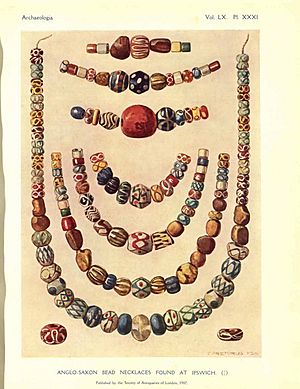Nina Frances Layard facts for kids
Quick facts for kids
Nina Frances Layard
FSA FLS
|
|
|---|---|
| Born | 20 August 1853 |
| Died | 12 August 1935 |
| Occupation | |
| Partner(s) | Mary Frances Outram |
Nina Frances Layard (born August 20, 1853, died August 12, 1935) was an amazing English woman. She was a poet, a prehistorian (someone who studies very old human history), an archaeologist (someone who digs up old things), and an antiquarian (someone who studies old objects).
Nina Layard did important digs and helped show that women could be great in fields like archaeology. She was one of the first four women to become a Fellow of the Society of Antiquaries of London. This was a big deal because it meant she was recognized by top experts. She also became a Fellow of the Linnean Society of London, which focuses on natural history. In 1921, she made history again as the first woman to lead the Prehistoric Society of East Anglia.
Contents
Nina's Early Life and Interests
Nina Layard was born in Stratford, Essex, on August 20, 1853. From a young age, she loved nature. She enjoyed collecting things like bird eggs and seashells. Even though she only went to a basic school, many smart people encouraged her interests. These included scholars like Leonard Jenyns and John Ellor Taylor.
In 1873, her family moved to Bath. Nina kept up her collecting there. She even traveled around the world in 1878-79, visiting places like New Zealand!
Discovering the Past: Nina's Archaeology Work
It was very unusual for a woman to lead archaeological digs back then, but Nina Layard did! Her first big dig was in 1898 at the Blackfriars monastery in Ipswich. She successfully found the old walls of the medieval buildings there.
From 1902 to 1905, she worked at a very old site called Foxhall Road in Ipswich. This was one of her most important contributions. Her work there helped prove that humans existed much earlier than people thought, even before the Ice Age! She also studied the stone tools found there, which helped people understand how these tools were made.
Later, in 1906-07, she dug at the Hadleigh Road site in Ipswich. This was an Anglo-Saxon cemetery that was going to be destroyed by a road project. Nina's quick work helped save important history. She documented 159 graves and the items buried with them. These items were sent to the Ipswich Museum. Even though she wasn't allowed to join the Society of Antiquaries because she was a woman, they still published her important findings.
Nina's Personal Life
Nina Layard moved to Ipswich around 1890. About five years later, she met Mary Frances Outram. They became partners and lived together. Mary helped Nina a lot with her research. She drew pictures for Nina's work and helped copy notes.
Mary Outram passed away in 1935. Nina Layard died shortly after, on August 12, 1935. They were buried together in the same grave. Their close partnership is remembered as an important part of Nina's story.
Nina's Family Connections
Nina Layard was the fourth child of Charles Clement and Sarah Layard. Her family had many interesting connections. For example, her father was a cousin of Sir Austen Henry Layard, who was famous for digging up ancient cities like Nineveh. Another cousin was Lady Charlotte Guest, who translated old Welsh stories.
Nina's mother, Sarah Somes, also came from an important family. Her brothers were big ship-owners in London. Nina's own brother, George Somes Layard, was a writer. So, Nina came from a family of curious and accomplished people!



